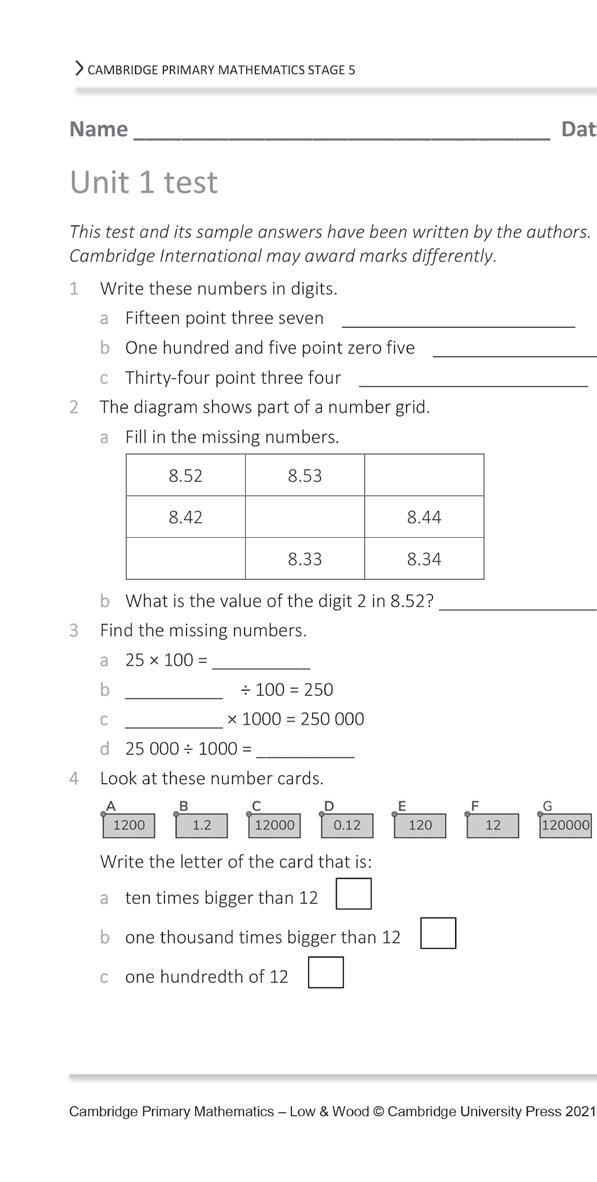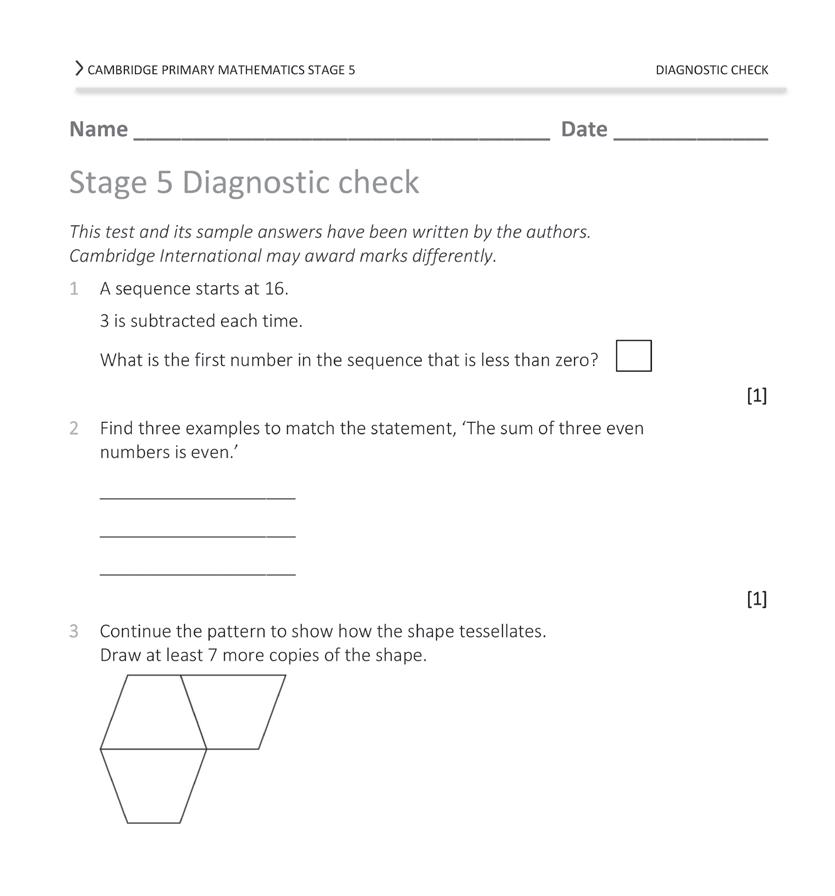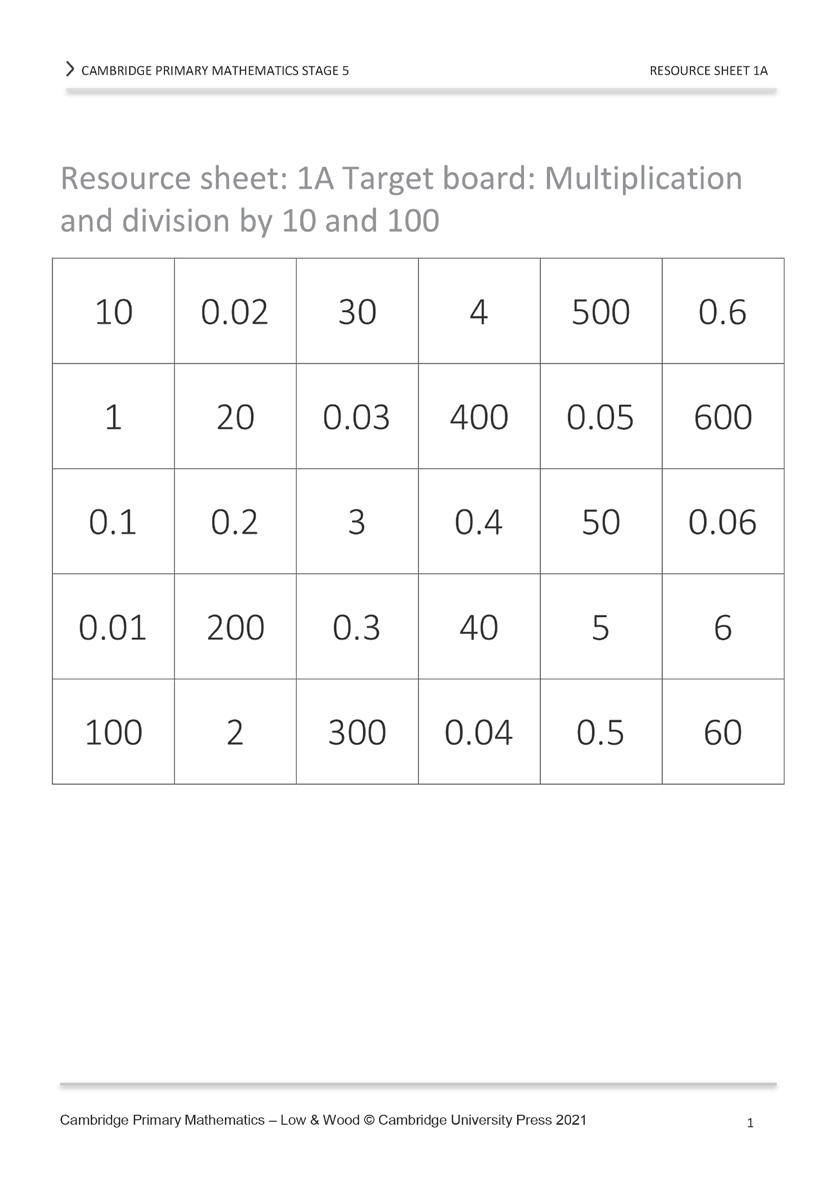
8 minute read
How to use this Teacher’s Resource
This Teacher’s Resource contains both general guidance and teaching notes that help you to deliver the content in our Cambridge Primary Mathematics resources. Some of the material is provided as downloadable files, available on Cambridge GO. (For more information about how to access and use your digital resource, please see inside front cover.) See the Contents page for details of all the material available to you, both in this book and through Cambridge GO.
Teaching notes
This book provides teaching notes for each unit of the Learner’s Book and Workbook. Each set of teaching notes contains the following features to help you deliver the unit.
The Unit plan summarises the topics covered in the unit, including the number of learning hours recommended for the topic, an outline of the learning content and the Cambridge resources that can be used to deliver the topic.
Topic
1.1 Understanding place value 4 hours Explain the value of a digit in a decimal (tenths and hundredths). Multiply and divide whole numbers by 1000. Learner’s Book Section 1.1 Workbook Section 1.1 Additional teaching ideas for Section 1.1 Resource sheet 1A
Approximate number of learning hours Outline of learning content Resources
Cross-unit resources
Diagnostic check and mark scheme Digital Classroom: Unit 1 multimedia enhancement Digital Classroom: Unit 1 activity Worksheet 1A
The Background knowledge feature explains prior knowledge required to access the unit and gives suggestions for addressing any gaps in your learners’ prior knowledge. Learners’ prior knowledge can be informally assessed through the Getting started feature in the Learner’s Book. (See the Assessment for Learning downloadable file section for more information.) BACKGROUND KNOWLEDGE
We are surrounded by numbers in our everyday life. Some of these are whole numbers and some are decimals. Having a display of pictures in the classroom can help learners to see how numbers affect their lives.
The Teaching skills focus feature covers a teaching skill and suggests how to implement it in the unit. TEACHING SKILLS FOCUS
Self-assessment You can create amazing lessons, but only your learners can do the learning. You will need to guide learners in how to approach their work and use feedback positively.
Reflecting the Learner’s Book, each unit consists of multiple sections. A section covers a learning topic. At the start of each section, the Learning plan table includes the learning objectives, learning intentions and success criteria that are covered in the section. It is helpful to share learning intentions and success criteria with your learners at the start of a lesson so that they can begin to take responsibility for their own learning. This also helps develop metacognitive skills.
The Language support feature contains suggestions for how to support learners with English as an additional language. The vocabulary terms and definitions from the Learner’s Book are also collected here.
LEARNING PLAN
Framework codes Learning objectives
5Np.01 • Understand and explain the value of each digit in decimals (tenths and hundredths). • Learners explain the value of a digit in a decimal (tenths and hundredths).
Success criteria
LANGUAGE SUPPORT
Column: arrangement of numbers or objects in a line, running up and down the page or surface Digit: the numbers 0, 1, 2, 3, 4, 5, 6, 7, 8 and 9. The value of the digit is determined by its position in a 2-digit number.
There are often common misconceptions associated with particular learning topics. These are listed, along with suggestions for identifying evidence of the misconceptions in your class and suggestions for how to overcome them.
Misconception Learners may consider hundredths to be greater than tenths. Through discussion and in written work. Ensure that place value charts are used as visual prompts.
How to identify How to overcome
For each topic, there is a selection of starter ideas, main teaching ideas and plenary ideas. You can pick out individual ideas and mix and match them depending on the needs of your class. The activities include suggestions for how they can be differentiated or used for assessment. Homework ideas are also provided.
Starter idea
Getting started (20 minutes)
Resources: Unit 1 Getting started exercise in the Learner’s Book. Description: Give learners 10 minutes to answer the Getting started questions in their exercise books.
Main teaching idea
Place value (20–30 minutes)
Learning intention: Understand and explain the value of each digit in decimals (tenths and hundredths). Resources: Resource sheet 1B.
The Cross-curricular links feature provides suggestions for linking to other areas of the Primary curriculum. CROSS-CURRICULAR LINKS
Work on the history of measurement will include reference to the metric system. The metric system is an internationally recognised decimalised system of measurement.
Thinking and Working Mathematically skills are woven throughout the questions in the Learner’s Book and Guidance on selected Thinking and Workbook. These questions, indicated by , incorporate specifi c characteristics that encourage Working Mathematically questions mathematical thinking. Learner’s Book Exercise 1.1, question 9 The teaching notes for each unit identify all of these Learners are given four statements, each with a questions and their characteristics. The Guidance on selected missing number, and have to work out which is the Thinking and Working Mathematically questions section odd one out. You may need to remind learners that then looks at one of the questions in detail and provides they need to calculate and then compare the missing more guidance about developing the skill that it supports numbers in order to identify the odd one out. Additional teaching notes are provided for the six NRICH projects in the Learner’s Book, to help you make the most of them. Projects and their accompanying teacher guidance have been written by the NRICH PROJECT GUIDANCE: PROJECT 1 POSSIBLY ODD Team. NRICH is an innovative collaboration Why do this project? between the Faculties of Mathematics and Education at the University of Cambridge, which focuses on problem solving and on creating opportunities for students to learn mathematics through exploration and discussion. https://nrich.maths.org. This task gives learners the opportunity to explore how multiplying by ten changes the value of each digit in a number with a decimal point. This activity develops the skill of conjecturing (TWM.03) by providing a context for learners to form different ideas about which numbers they should choose to put in which boxes, helping them
Digital Classroom: If you have access to consolidate their understanding of place value. Digital Classroom, these links will suggest when to use the various multimedia enhancements and interactive activities.
Digital resources to download
This Teacher’s Resource includes a range of digital materials that you can download from Cambridge GO. Helpful documents for planning include: • Letter for parents – Using the Cambridge Primary and Lower Secondary resources: a template letter for parents, introducing the Cambridge Primary Mathematics resources. • Lesson plan template: a Word document that you can use for planning your lessons. Examples of completed lesson plans are also provided. • Curriculum framework correlation: a table showing how the Cambridge Primary Mathematics resources map to the Cambridge Primary Mathematics curriculum framework. • Scheme of work: a suggested scheme of work that you can use to plan teaching throughout the year. Each unit includes: • Additional teaching ideas: additional starter, main and plenary activity ideas are provided for each section in the unit. • Differentiated worksheets: these worksheets are provided in variations that cater for different abilities. Worksheets labelled ‘A’ are intended to support less confident learners, while worksheets labelled ‘B’ are designed to challenge more confident learners. Answer sheets are provided. • Language worksheets: these worksheets provide language support and can be particularly helpful for learners with English as an additional language. Answer sheets are provided. • Resource sheets: these include templates and any other materials that support activities described in the teaching notes. • End-of-unit tests: these provide quick checks of the learner’s understanding of the concepts covered in the unit. Answers are provided. Advice on using these tests formatively is given in the
Assessment for Learning section of this Teacher's Resource. Additionally, the Teacher’s Resource includes: • Diagnostic check and mark scheme: a test to use at the beginning of the year to discover the level that learners are working at. The results of this test can inform your planning. • Mid-year test and mark scheme: a test to use after learners have studied half the units in the
Learner’s Book. You can use this test to check whether there are areas that you need to go over again. • End-of-year test and mark scheme: a test to use after learners have studied all units in the
Learner’s Book. You can use this test to check whether there are areas that you need to go over again, and to help inform your planning for the next year. • Answers to Learner’s Book questions
• Answers to Workbook questions • Glossary
In addition, you can find more detailed information about teaching approaches. Audio is available for download from Cambridge GO (as part of this Teacher’s Resource and as part of the digital resources for the Learner’s Book and Workbook). Video is available through the Digital Classroom.



















